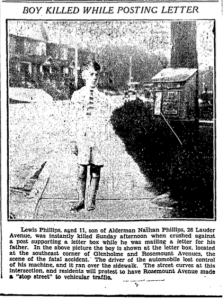Nathan Phillips Square at Toronto City Hall has become a popular spot for advocacy groups to demand safe streets, including the call for lower speed limits. It is a fitting venue.
In the 1920s when the increase in motor cars resulted in a surge in road deaths and serious injuries it seemed that no one, and no place, was safe. On Mother’s Day in May 1929, 11-year-old Lewis Phillips volunteered to mail a letter for his father, Nathan, then a city alderman.
Since the carnage of the 1920s, countless billions of dollars have been invested in making roads and vehicles safer but no amount of education, enforcement, engineering, vehicle improvements — or grief — has yet succeeded in overcoming the imbalance between the inherent danger of motor vehicles and the vulnerability of humans.
Lower speeds offer the opportunity to harness or manage the motor vehicle’s deadly potential — the result of its speed, size and power. Lower speeds make collisions both less likely, because the pedestrian or motorist has a better chance of avoiding a collision, and less likely to be deadly.
We know that a pedestrian hit by a car travelling 30 km/h, although a horrible experience, will almost certainly survive but with each increment in speed, the pedestrian’s chances of survival diminish. At 50 km/h, the pedestrian is as likely to die as to survive.
It’s not just motorists’ speed that causes problems. Pedestrians, especially distracted ones, rushing along a sidewalk might bump into another person, earning an angry scowl or rebuke. Likewise, a speeding cyclist may frighten or even injure a pedestrian. The difference is in motorists’ immeasurably greater capacity to cause harm.
It’s true that some deaths, particularly ones involving right-turning trucks, occur at relatively low speeds. However, if vehicles from various directions are approaching more slowly, a truck driver has more time to make a complex decision.
Lower speeds help to fundamentally change the road safety equation, even though it’s not the only element of a safety strategy. Criminal charges, for example, serve as both punishment and deterrent for serious misconduct.
In fact, the motorist who hit Lewis was charged with manslaughter. But he was acquitted — the court characterizing the tragedy as an accident. The driver had slammed on his brakes to avoid colliding with another car with the right of way in the intersection, but in swerving, his foot slipped onto the accelerator. Lower speeds could have avoided the “accident” altogether.
Many cities are reluctant to lower speed limits, apparently concerned about increasing driving times. Instead, all road users, including children, are exhorted to be perfectly attentive at all times, and to perfectly follow all rules. Whatever the benefits of this strategy, it often deflects attention from the inherent danger of motor vehicles. Walking in itself, for example, isn’t a particularly risky activity.
The underlying premise of Vision Zero road safety strategies, on the other hand, is to accept that all humans make mistakes. Lower speeds prevent those inevitable mistakes — by motorist, pedestrian or cyclist — from becoming fatal or serious injuries.
In implementing Vision Zero in Toronto, the city has lowered speed limits to 30 and 40 km/h on some roads. This is an important start, but it must be expanded across the city — and enforced. Speed cameras are a proven technology effective not only in reducing speed but collisions and injuries. The city and province must co-operate to put these cameras in place, now.
An effective Vision Zero plan includes road redesign to acknowledge and “forgive” the inevitable human error. So instead of signs limiting speed, the redesigned roads will give visual cues to motorists to drive slowly. But such changes take time; we can’t simply watch and wait, and mourn our losses.
Perhaps in 1929, we could still believe that education, calls for courtesy, and criminal sanctions would end the carnage. Ninety years later, we can’t be so naïve. Lower speeds help us prevent the type of calamities that make Nathan Phillips Square a fitting place to fight for safe streets.
Albert Koehl, a road safety advocate and lawyer, served on the Coroner’s 2012 expert panel on pedestrian safety, which recommended lower speed limits.
